
Figure 1.
The object of pruning is to remove a branch but not cut so much off that it leaves a big wound. If you cut along the red line (cut the branch off smooth with the trunk) a large wound is left for the tree to heal. Pruning along the green line leaves a “bump” but this smaller wound will heal more quickly and be less prone to disease. As the tree continues to grow this bump will be incorporated into the trunk
Pruning is as much an art as it is a science. Many factors come into play when deciding whether or not to lop off a branch. This information will help you make the best pruning decisions that will promote desired growth. First, buy a good set of pruners and keep them sharp. Sharp blades cut woody tissue without crushing adjacent cells. In the nursery we use 1” bypass pruners. These have a large enough opening to prune anything that needs it in the nursery.
The actual pruning of the branch is not a haphazard cut. If you are trying to remove the branch entirely, look carefully at Figure 1. Three points are illustrated: the trunk of the tree, the branch itself, and the collar that connects the two. The collar can be identified as the point where the branch expands and “fastens” to the trunk (Figure 1; shaded area) When making the pruning cut, you want to leave the collar on the tree (Figure 1; green line) while not leaving a stub of a branch. Just to the inside of the collar are cells that function to seal the wound after pruning and you do not want to remove those. If pruning cuts are made inside of the branch collar (Figure 1; red line) the wound is larger, takes longer to close and is thus subject to infection. Figure 2 illustrates pruning cuts that are actively closing. At the bottom green arrow you can easily see the bump that should be left on the trunk when you make a correct pruning cut. Within one growing season the wound closing process will be complete. The normal bark texture will return after a couple more growing seasons and all signs of pruning will be gone.

Figure 2.
Two pruning scars are illustrated. The top scar is closing nicely as it should if you leave the collar and don’t prune too close to the trunk. The lower pruning scar shows the bump that is left if you correctly prune the branch back and leave the collar. This tree was pruned early in spring and one year later the wound is nearly healed.
First a couple of terms:
Apical dominance: This refers to the bud at the tip of the trunk or branch suppressing the growth of any lateral (or side) branches. There is a hormone produced in the tip that keeps the side branches from growing in the first place. If you prune this tip off, the hormone is removed, and the lateral branches begin to grow. For this reason, when you cut the tip off of a stem, branching begins behind that cut.
Leader: This is the central axis or stem of the tree. You only want one leader on a tree. If two leaders emerge they will compete with one another, producing a fork in the trunk. Sometimes individual trees develop a forked trunk naturally, but in the nursery we would prune them to a single leader. This gives us the best growth in height. Birches and redbuds are trees that often have several leaders extending up from the soil. This gives the plant a multi-trunked appearance which is desirable in those species, but not in oaks or maples.
Vigor: Vigor refers to how quickly a tree or a branch grows. IMPORTANT: side branches will grow bigger and faster (more vigorously) than the leader. At least initially, this side growth is not desired in the nursery. Pruning helps to keep these lateral branches in check, thus giving the leader a chance to grow.
So the mission here is to promote the growth of the leader while suppressing side growth by pruning. Most of this is already done in the nursery, but sometimes the planting process disturbs apical dominance, which promotes the undesired side branch growth. Below are listed a few things you can do to help your tree grow straight and upright once you have planted it. At the very bottom of this page is a photoclinic with common pruning problems and how to solve them.
How to Determine Whether to Prune a Branch

Figure 3.
This Swamp White Oak has lost its central leader; the single trunk that grows straight up. Instead there are a number of equally sized branches growing from a single point. Choose the straightest of the branches and prune the rest of them off. If needed, stake and tie the new leader so that it grows straight.
See our clinic on staking and tying trees.
1) Remove branches that will compete with the leader. These are called leader competers. See Figure 3. This side branch is relatively thick and will compete with the leader for nutrients. Removing it completely will promote the growth of the leader. If in doubt, cut the competer back by one-third or one-half. The rest can be pruned off later if needed. If it is a low branch you can remove it completely. Our rule of thumb in the nursery is that if a lateral (side) branch is one-third or more the diameter of the actual leader we either cut it off or cut it back.
2) Remove most branches in a whorl. In Figure 4 there are five branches growing from the same point on the trunk. This is called a whorl and it is not good branching structure in hardwood trees, It probably resulted from a loss of apical dominance when the seedling was planted. Choose the straightest one to become the new central leader and prune the other four adjacent branches off completely. The two branches below this could be kept but cut back by half as they are growing a little too vigorously. Don’t forget to leave the collar when you make your pruning cut (see paragraph 2 above). If the new central leader is not straight it can easily be staked with bamboo and tied.
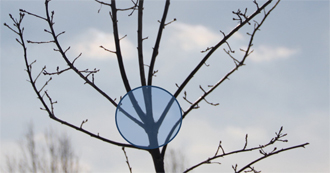
Figure 4.
A whorl is a structurally weak point on a tree.
3) Apical Bud Pruning. Oaks can be forced to grow faster in height if you remove some of the buds on and near the tip of the leader. This can be done in winter before the oaks break bud or whenever the tree is flushing new growth. You do this by removing selected buds at the very tip of the leader and for the first 1 or 2 inches below the tip. Oaks typically have their buds in clusters at the tip of the leader. Find the biggest bud (usually the center bud, but sometimes a bud beside that center bud) at the tip of the leader and remove all the other buds in that cluster with your fingernail. Just rub them off. See Figure 5. Leave the single biggest, healthiest looking bud in that cluster. Also, remove the first four or six buds beneath this cluster too. In effect, you are giving the tree only one option to grow: up from that central bud. As you can see, the tip bud that remains is already pointing upwards and will make good caliper new growth. In my own landscape, I apical bud prune as long as I can reach the buds at the tip of the leader. It really promotes growth in height and I think it works so well that I have to resist the urge to get the ladder out to reach the next set of buds on my big Bur and Swamp White Oaks.
Figure 5.
When apical bud pruning side buds at the terminal end of the tree are removed leaving only the large central bud. Any buds within the top 2 inches are removed as well. This will allow the central leader to grow more quickly and without competition from other, more aggressive lateral branches.
Left photograph, before; Right photograph, after.
If you are unsure about apical bud pruning in the winter, you can wait until the buds have begun to grow in the spring. When the buds have broken (started growing) and you have 4-6” of new growth appearing, you can nip the vigorous side branches at the tip of the leader if they need it. Just pinch them off with your fingernail or prune them with pruners. To determine if this new growth needs pruning, simply see if the leader is the longest new growth present. If it is, pruning may not be necessary yet. If there is more than one new branch extending upwards (having a leader competer,) choose the straightest, thickest one and prune off the other(s) entirely. You can leave a lateral branch or two at this tip if you think the branching structure is adequate but do cut them back one-third to one-half just so they don’t start getting the idea they they are the leader. If we get three or four flushes of growth in a growing season, then we check and prune as above three or four times that season. I am always trying to force the tree to grow upwards and to keep vigorous lateral branches from competing with the leader. I like to get this pruning done while the new growth is still small and before the tree has invested a lot of energy in it. I would prefer the energy to go to promote the growth of the leader. Once the tree is too tall to reach easily it generally will not need to be pruned.
4) Re-establishing a Leader. Sometimes the leader becomes broken, damaged, or is eaten by deer. A little bit of action on your part will help to create a new leader on the tree and allow it to continue growing well. First, stake the tree using a length of bamboo or 1/2″ conduit. Click here for information on proper staking. Examine the remaining branches and choose one that looks healthy and is flexible enough that it could easily be bent and pointed upward. Gently (and without crimping the stem) bend this branch upward and tie it loosely to the stake using your tying tape. If the best candidate for the new leader it is too short to tie up easily, let it grow for a month or so and then tie it up. Initially, this will produce a dog-leg in the trunk, but as the tree gets older and builds caliper, this will become less and less pronounced. If any of the old leader remains prune it out completely. Watch the other, adjacent branches to make sure they don’t begin to compete with the leader. Cutting these potential competers back by one-third or one-half will help them know who’s boss. If you like the tree’s shape, however, you can leave it alone. You can always prune later.
We try to keep the nursery trees roughly conical or pyramidal in shape, but in our landscape we let them grow on their own, since their genetics will ultimately be the best arbiter of the tree’s growth and shape. We do keep an eye on branches that seem to want to compete with the leader, and we cut these off or back by half as needed. If in doubt, we let them grow a bit longer to see what they are planning to do.
After a couple of seasons, genetics determines the final branching pattern. Apical bud pruning when the tips are still reachable is the last maintenance we do on the tree other than to fertilize and to correct an occasional errant branch. We have selected seeds from trees with good genetics (based on what we see in the parent trees) as our growing stock, so we can just let them go and do what they are genetically predisposed to do.
If you have any questions please call Riverside Native Trees and Nursery, LLC at 740-815-3230 or email us at ekapraly@gmail.com
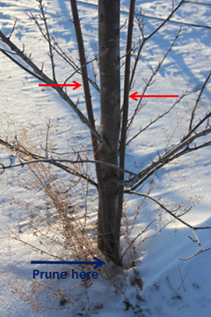
This tree has two relatively large suckers growing up from the base of the trunk. These will compete with the leader and as they grow larger will begin to rub against the main trunk. Prune them back at the point where they are attached to the trunk. It would have been better to prune them before they got this large.
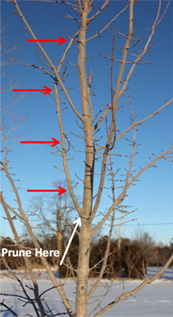
This photograph illustrates a branch that is not growing as it should. It curves back in towards the trunk and is rubbing against other branches. Ideally this would have been pruned when the tree was younger as it is a fairly thick branch. Making the pruning cut indicated will leave a gap in the canopy that will be filled in relatively quickly with new growth.

This tree has a good central leader (1 ) but it also has a lateral branch (2) that is growing too vigorously. Note how similar they are in diameter. When this happens the lateral branch may actually outgrow the central leader giving the tree an undesirable shape. The lateral branch is worth saving, however, because it is well formed and it is the only branch on that side of the tree. Prune it back by half instead of removing it completely.
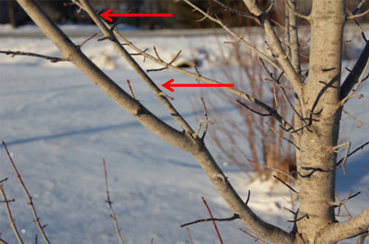
This branch comes off at an odd angle and does not add anything structurally to the shape of the tree. Prune it off at the junction with the larger branch.
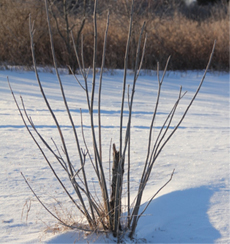
The main trunk of this tree was broken off during a storm. Numerous suckers then developed and must be thinned to one new trunk. Find the straightest one and prune the rest off. Stake the new trunk if necessary. The old, broken trunk might be helpful to secure the stake to the new trunk so don’t cut it off just yet.